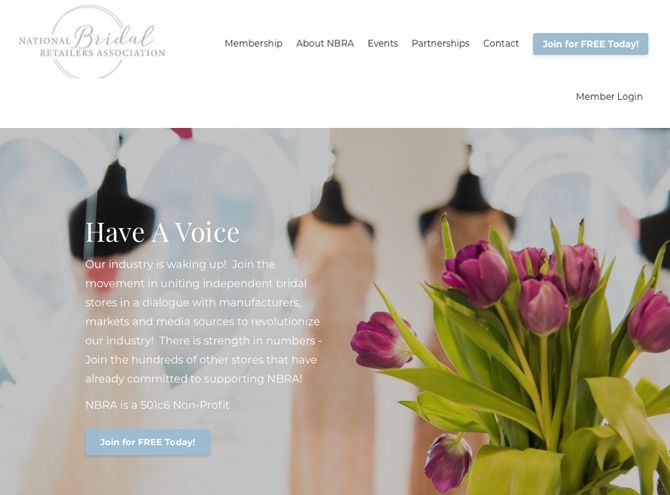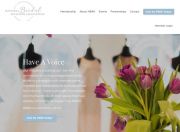The National Bridal Retailers Association’s recent webinar entitled “Website and Sales Tips for a Challenging Time,” drew more than 100 retailers to a spirited conversation featuring Alan Berg, CSP, and Brian Lawrence, SEO Expert, and successfully launched the association’s new cost-free basic membership.
Access to the recorded webinar is available to attendees, and as a bonus for new membership signups at www.NationalBridalRetailersAssociation.com.
“This was a very informative and successful event, both from an information point of view and membership launch,” said Michelle McFarland, president of NBRA and owner of The Wedding Shoppe, Michigan. "We always love hearing from Alan Berg.
"His knowledge of the bridal industry, as a whole, is unsurpassed. His generous offer to speak to our NBRA Members was a gift and came at the perfect time! Store-owners and Stylists are struggling to adapt to our current circumstances. Our old way of ‘selling’ is not working any longer. His understanding of our customer and his clear, concise delivery of the information helped all that attended connect and guide more brides to their dream wedding dress.”
For those unable to attend the webinar, VOWS asked Alan Berg to provide a summary of his presentation:
The 4 steps to more sales are:
Get their attention
Get them to make an inquiry
Have a conversation
Make the sale
These steps apply to almost any business, not just wedding businesses. To decide how to get their attention, look for where your target audience is looking for someone like you. Not just where they are hanging out (social platforms), but where they’re actively looking for a dress or accessories.
To get more inquiries, be very specific about the calls to action. Tell them why they’re inquiring (make an appointment, get a quote, ask a question, etc.) and then make it easy for them to take that action.
Conversations these days can be in-person, phone, email, web conference (Zoom, Skype, Google Hangout), text, WhatsApp, live chat, social messaging, inquiry through your website, inquiry through an advertising platform, etc. Since we’re dealing mostly with digital natives, learning how to have better digital conversations will help you get them to the next steps easier and faster.
Making the sale is about asking better questions and really listening to the answers. You can shorten the sales process by not assuming what’s important to each customer, rather keeping an open mind and asking better questions so you can determine what’s important to this customer.
When you present the customer with too many choices, you create decision-paralysis. That’s when they choose not to decide at all. We’re all susceptible to this when we’re the customer. If you’ve been shopping on Amazon.com recently, then you know that you can easily get caught by “if you like this product, you might like this other one” and “people who bought this also looked at these other products.” If you’ve ever stepped away without buying because you couldn’t decide from all of the options… that’s decision paralysis.
Before presenting any choices to the customer, it’s better to ask good questions to help you narrow the choices. Then, only present the customer with the choices that will satisfy their needs, so you avoid creating decision paralysis. There’s a great book called “The Paradox of Choice” by Barry Schwartz, which explains this well.
Top Down Selling is really listening to the customer’s needs and wants, and presenting them with choices that get them the results they desire, regardless of budget. You don’t totally ignore their budget, but if they can’t get the results they want, at the budget they set, they’re going to have to compromise.
All budgets are made up. That’s right, someone had to make up that number. Sometimes there’s real thought and science behind it, and other times it’s arbitrary, maybe from a survey they read, or other source. We’ve all spent more on something we really wanted than we had originally planned. If they still say it’s more than they can spend, then you start coming down until you get to a point where their wants, needs and budget align.
If they don’t buy today, then you want to try to get a very specific next step. Ambiguous next steps bring ambiguous results. Specific next steps yield specific results. If they say they want to sleep on it, then make another appointment for them to come back. If they won’t agree to the appointment, get them to agree to a virtual appointment or call, at a specific date and time. You’re not only trying to get the appointment you’re trying to see how interested they really are. If they agree to it, they’re more interested than if they are reluctant.
When it comes to getting appointments, following up and asking for the sale, here’s a phrase to live by: “If you don’t ask, the answer is always no!” How often should you follow up? A better question is: How badly do you want/need the sale? Keep following up until you get a yes or no. Anything else is a “maybe”, and maybes don’t pay the bills. At least with a ‘no’ you can try to get the sales for accessories, bridesmaids and/or men’s formalwear.
Alan Berg has been called “The Leading International Speaker and Expert on the Business of Weddings & Events.” In addition to writing 5 books, Alan has presented in 14 countries (5 of them in Spanish!). He travels the world helping businesses, like yours, attract and convert more couples, so you get to do more of what you love – help them have amazing weddings! To find out more about him, and his speaking, consulting, sales training and website review services at www.AlanBerg.com




